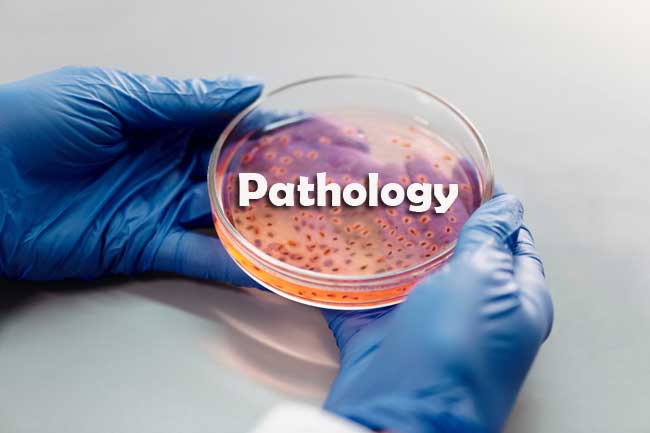Pathology Sample Question
Pathology Sample Question Papers Free Pdf is available. Download Pathology Sample Papers from the below attachments for free of cost. Pathology Sample Papers will definitely helpful for the aspirants to get an idea about the previously asked questions.

Here we provided Sample Question Papers of Pathology. Pathology Sample Papers is given below. The Aspirants who applied for the latest Pathology Recruitment for can check the Pathology Exam Sample Papers and Study Material in the sections below.
Sample Question on Pathology
1. FIGLU excretion test is used for assessment of deficiency of
(1) Vitamin B12
(2) Pyridoxine
(3) Folic Acid
(4) Niacin
2. In Down Syndrome there is non-dysjunction of chromosome :
(1) Chromosome 13
(2) Chromosome 15
(3) Chromosome 18
(4) Chromosome 21
3. Which of the following changes best describe the pathophysiology involved in the production of pulmonary oedema in patients with congestive heart failure ?
(1) Wide spread endothelial damage
(2) Decreased plasma oncotic pressure
(3) Increased hydrostatic pressure
(4) Acute lymphatic obstruction
4. All are reversible injury of cell, except :
(1) Vacuole
(2) Karyorrhexis
(3) Fat accumulation
(4) Cell wall swelling
5. Which cells can lyse tumour cells or virus injected cells without prior sensitization ?
(1) B Cells
(2) T Cells
(3) NK Cells
(4) Macrophages
6. Pro-apoptotic proteins are :
(1) bel 2—bel x L
(2) bel 2-Mel-1
(3) Bax and Bak
(4) Ced9
7. In cell death myelin figures are derived from
(1) Plasma Membrane
(2) Cytoplasm
(3) Nucleus
(4) Mitochondria
8. Wear and tear pigment in the body refers to
(1) Melanin
(2) Lipochrome
(3) Haemosiderin
(4) Anthracotic pigment
9. All are features of carcinoma, except :
(1) Anaplasia
(2) Metaplasia
(3) Dysplasia
(4) Autonomous
10. Not a premalignant condition :
(1) Ulcerative colitis
(2) Achalasia cardiac
(3) Xeroderma pigmentosa
(4) Barrettes oesophagus
11. Which of the following is oncogenic RNA virus ?
(1) HPV
(2) HHV-8
(3) HTLV-1
(4) EBV
12. Which of the complement components act as a chemo-attractant ?
(1) C4b
(2) C4a
(3) C3b
(4) C55a
13. Which of the following is autosomal recessive disorder ?
(1) Marfan Syndrome
(2) Hereditary Spherocytosis
(3) Homocystinurea
(4) Myotonic dystrophy
14. HLA-B 27 is associated with
(1) Rheumatoid arthritis
(2) Osteo arthritis
(3) Ankylosing Spondylitis
(4) Suppurative arthritis
15. The most common cause of acute bacterial meningitis in neonates is
(1) Listeria monocytogenes
(2) H. influenza
(3) Escherichia coli
(4) Streptococcus pneumonia
16. All are antigen presenting cell, except :
(1) Langerhan’s cells
(2) Dendritic cells
(3) T-Cells
(4) B-Cells
17. Cytokeratin is a tumour marker for
(1) Melanoma
(2) Carcinoma
(3) Sarcoma
(4) Lymphoma
18. Soft chancre is caused by
(1) Syphilis
(2) Tuberculosis
(3) Chancroid
(4) L. donovaoni
19. All are cellular adaptation, except –
(1) Hypertrophy
(2) Hyperplasia
(3) Necrosis
(4) Metaplasia
20. Which Thyroid carcinoma has amyloid deposition ?
(1) Anaplastic
(2) Papillary
(3) Follicular
(4) Medullary
| Mock Test | Practice Set |
| Important Questions | Quiz |
| Sample Papers | MCQ |
| Model Question | Questions and Answers |
21. Red infarct is seen in
(1) Liver
(2) Brain
(3) Kidney
(4) Lung
22. CD marker for cytotoxic T cells :
(1) CD4
(2) CD8
(3) CD21
(4) CD45
23. Fatty liver is due to accumulation of
(1) Lipoprotein
(2) LDL
(3) Triglyceride
(4) VLDL
24. A simple bacterial test for mutagenic carcinogens is
(1) Ames test
(2) Redox test
(3) Bacteriophage
(4) Gene Splicing
25. Acanthosis means
(1) Loss of intracellular connection
(2) Abnormal premature keratinization
(3) Diffuse epidermal hyperplasia
(4) Thickening of stratum corneum
26. Hemartoma is
(1) Malignant tumour
(2) Benign tumour
(3) Haemorrhage in vessel
(4) Development malformation
27. Liquefactive necrosis is seen in
(1) Heart
(2) Brain
(3) Lung
(4) Spleen
28. Squamous Cell Carcinoma spread commonly via
(1) Implantation
(2) Haematogenous Spread
(3) Lymphatic Spread
(4) Transcoelomic Spread
29. Heart failure cells are
(1) Lipofuscin granules in cardiac cells
(2) Pigmented alveolar macrophages
(3) Pigmented pancreatic acinar cells
(4) Pigmented cells in liver
30. Excessive fibrosis tumours is called
(1) Anaplasia
(2) Metaplasia
(3) Dysplasia
(4) Desmoplasia
31. What is hyperplasia ?
(1) Decrease in cell size
(2) Increase in cell size
(3) Increase in cell number
(4) Decrease in cell number
32. Which of the following cellular adaptation may be irreversible ?
(1) Atrophy
(2) Metaplasia
(3) Hyperplasia
(4) Hypertrophy
33. Calcification in necrotic tissue is called :
(1) Metastatic Calcification
(2) Dystrophic Calcification
(3) Calcinosis
(4) Tumoral Calcinosis
34. Epithelioid cell is a modified :
(1) Lymphocyte
(2) Eosinophil
(3) Mast Cell
(4) Macrophage
35. Fat necrosis occurs in
(1) Omentum
(2) Heart
(3) Kidney
(4) Brain
36. Diabetic foot is associated with following type of gangrene :
(1) Dry gangrene
(2) Wet gangrene
(3) Gas gangrene
(4) Fournier’s gangrene
37. Russell bodies are seen in
(1) Lymphocytes
(2) Neutrophil
(3) Macrophage
(4) Plasma cell
38. Rubor in inflammation is due to
(1) Dilation of arterioles
(2) Increased vascular permeability
(3) Increased viscosity of blood
(4) Edema
39. Opsonins are
(1) C3a
(2) IgM
(3) IgE
(4) Sclectins
40. Grade of tumour denotes
(1) Degree of differentiation
(2) Stage of disease
(3) Vascular invasion
(4) Degree of anaplasia
41. The most common source of embolism :
(1) Deep Vein Thrombosis (DVT)
(2) Trauma
(3) Infection
(4) Surgery
42. Hereditary angioedema is due to deficiency of
(1) Angiotensin
(2) Angiotensin converting enzyme
(3) C1 inhibitor
(4) Histamin
43. Autoimmunity is caused
(1) Inappropriate selection of MHC proteins
(2) Negative selection of T cells in thymus
(3) Expression of cryptic antigens
(4) Pressure of forbidden clones
44. Which cell type lacks HLA antigen ?
(1) Monocyte
(2) Thrombocyte
(3) Neutrophil
(4) Red blood cell
45. Immune system in the body is activated by
(1) Cell adhesion molecules
(2) Cytokines
(3) G-protein receptors
(4) Ion Channels



